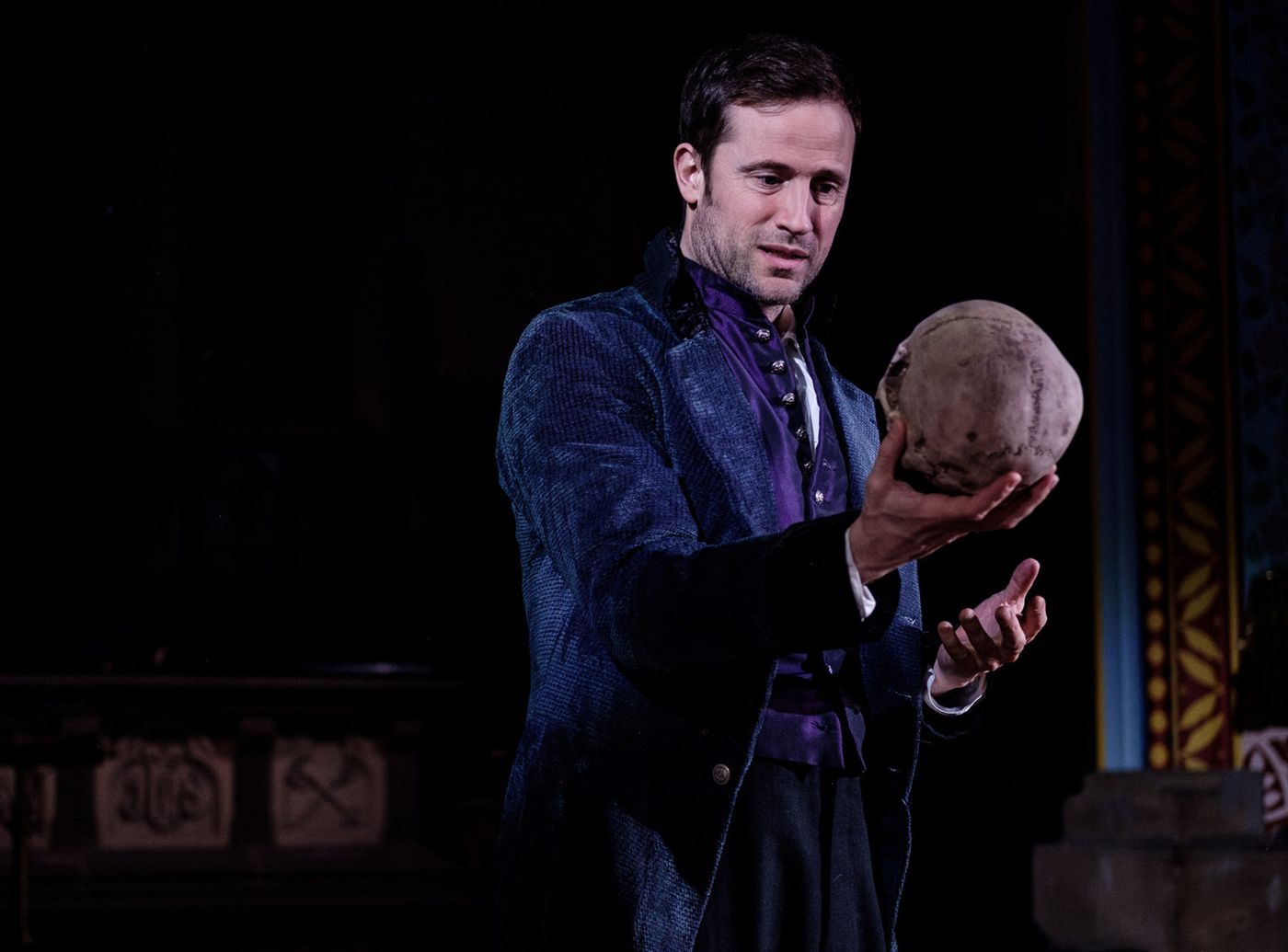Review: Jersey City's Grace Church turns into Elsinore for HAMLET by Shakespeare@

Church, thy name is theater.
Shakespeare@ kicks off their inaugural run in Jersey City with a sharp production of HAMLET. William Shakespeare's Danish tragedy of revenge and mental insanity transforms the space of Grace Church Van Vorst, a New Jersey Episcopal church on the National Registry of Historic Places.
The first few minutes of this HAMLET are in Wittenberg as the prince studies beside his school chums with inaudible whispers; the rest, as they say, is silence. The audience does not hear any dialogue until Hamlet begins his famous "to be or not to be" soliloquy, moved up from Act 3 to be juxtaposed with Hamlet reading a letter and learning of his father's death. Beneath the scene, the sound of what seems to be a ticking clock quickly turns into the pulsating heart beat of Hamlet as he begins his swift descent into madness.
Back in Denmark for the wedding of his mother and uncle, Hamlet starts taking shots at his new father and ruler. When he utters "I am too much i' the sun," Hamlet is standing directly in front of the star-bright lights. Throughout HAMLET, the stark lighting of mostly blue and white as designed by Sarah Johnston does a great job of heightening the drama and mood.
Jonathan Forbes plays the title prince with appropriate anguish. Each of his nasty insults sends a proper dagger while his emotional turbulence is spot-on without neglecting the sympathetic side of the character. Forbes also does a great job of starting Hamlet in a place of anger and resentment but keeps digging deeper into the troubled psyche.
In the tradition of great Shakespeare siblings, Eden Brolin as Ophelia and Aria Shahghasemi as Laertes are each dynamic in their own right but bring an other-worldly connection in the two scenes they share. There is no doubt of the bond between Laertes' anger, Ophelia's sorrow, and the filial dedication they experience.
While her brother deservingly demands attention, especially in his later scenes leading up to the climax, Ophelia steals with her hauntingly beautiful voice in song. She clearly depicts how Hamlet's madness is contagious and how she was caught with it and with grief. For those who already know HAMLET, Ophelia's expected end is unexpectedly tragic in this staging.
Mark Torres and Thia Stephan present a complicated royal elegance as King Claudius and Queen Gertrude. Andrew Sellon well balances the comedic and dramatic as Polonius. Franics Mateo's Horatio delivers stunning loyalty to Hamlet and Rosencrantz and Guildenstern (Fernando Hernández and André Revels) are a joy to watch on stage, even with their downsized roles. Robert Steven Anderson, Tenzin Yeshi, Alice Marks, Wesli Spencer, Mark J. Quiles, and David Hargreaves round out the cast that blends so well together.
Due to HAMLET being a text that requires a minimum four hours to perform in full, much was rightly excised from this production to make the run time a bearable two and a half hours. The necessary cuts unfortunately eliminated the character of Fortinbras as well as the ability to dig deeper into some of the themes of HAMLET- most notably feminism- but some sacrifices are to be expected in any production of the play.
The most notable aspect of Shakespeare@'s HAMLET is of course the setting. The bulk of the action takes place in the center of the large hall, with the actors standing at the same level as the audience, not above. Without microphones or the booming voice of a pastor, words are often swallowed by the high ceilings and wide wings of the church. The acoustics are not appropriate for theater. With the audience surrounding the cast in a flat-thrust stage, it becomes hard to hear an actor when their back is turned to you.
However, the use of the space more than makes up for the difficult to hear portions. The church is used especially well when the ghost of King Hamlet visits his son, when Claudius attempts to repent, and in the graveyard scene. Director Sean Hagerty is to be applauded for his meritorious recognition of the space, counteracting the threats and embracing the opportunities that Grace Church afforded.
Credit is also due to sound designer Donghyk Chang who helps create a perverse environment with ephemeral noises and cerebral effects. Fight director Brad Lemons should also be lauded. In the final showdown between Laertes and Hamlet, both are effective enough with their rapiers to be believably skilled and trained. With the use of adequate space as befits a royal palace like Elsinore for the fight sequence, the efficient duel is perfectly tense and realistic.
Shakespeare@ is presenting HAMLET at Grace Church Van Vorst in Jersey City until April 14. Performances are at 7:30 pm on Thursdays, Fridays, and Saturdays, and at 7:00 pm on Sundays. Tickets cost $25. More information can be found at https://www.shakespeare-at.org/.
Photo Credit: Will O'Hare
Reader Reviews
Videos

